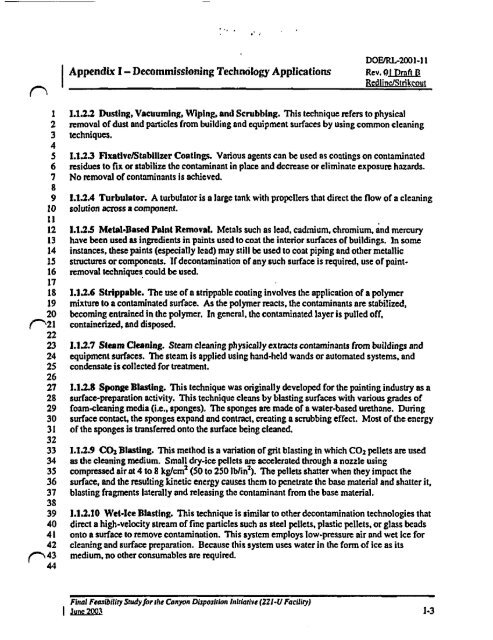View Document Here - Hanford Site
View Document Here - Hanford Site
View Document Here - Hanford Site
Create successful ePaper yourself
Turn your PDF publications into a flip-book with our unique Google optimized e-Paper software.
DOFIRI.-2001-11<br />
( Appendix I - Decommissioning Technofogy Applications Rev. p l Dr t(f3<br />
Redline/Strikcut<br />
n 1 1.1.2.2 Dusting, Vacuuming, Wiping, and Scrubbing. This technique refers to physical<br />
2 removal of dust and particles from building and equipment surfaces by using common cleaning<br />
3 techniques.<br />
4<br />
5 1.1.2.3 Fxative/Stabilizer Coatings. Various agents can be used as coatings on contaminated<br />
6 residues to fix or stabilize the contaminant in place and dccrease or eliminate exposure hazards.<br />
7 No removal of contaminants is achieved.<br />
9 1.1.2.4 Turbulator. A turbulator is a large tank with propellers that direct the flow of a cleaning<br />
10 solution across a component.<br />
I1<br />
12 1.1.2.5 Metal-Based Paint Removal. Metals such as lead, cadmium, chromium, and mercury<br />
13 have been used as ingredients in paints used to coat the interior surfaces of buildings. In some<br />
14 instances, these paints (especially lead) may still be used to coat piping and other metallic<br />
15 structures or components. If decontamination of any such surface is required, use of paint-<br />
16 removal techniques could be used.<br />
17<br />
18 1.1.2.6 Strippable. The use of a strippable coating involves the application of a polymer<br />
19 mixture to a contaminated surface. As the polymer reacts, the contaminants are stabilized,<br />
20 becoming entrained in the polymer. In general, the contaminated layer is pulled off,<br />
("""^21 containerized,and disposed.<br />
22<br />
23 1.1.2.7 Steam Cleaning. Steam cleaning physically extracts contaminants from buildings and<br />
24 equipment surfaces. The steam is applied using hand-held wands or automated systems, and<br />
25 condensate is collected for treatment.<br />
26<br />
27 I.1.2.8 Sponge Blasting. This technique was originally developed for the painting industry as a<br />
28 surface-preparation activity. This technique cleans by blasting surfaces with various grades of<br />
29 foam-cleaning media ( i.e., sponges). The sponges are made of a water-based urethane. During<br />
30 surface contact, the sponges expand and contract, creating a scrubbing effect. Most of the energy<br />
31 of the sponges is transferred onto the surface being cleaned.<br />
32<br />
33 1.1.2.9 CO2 Blasting. This method is a variation of grit blasting in which CO2 pellets are used<br />
34 as the cleaning medium. Small dry-ice pellets are accelerated through a nozzle using<br />
35 compressed air at 4 to 8 kg/cm2 (50 to 250lblini). The pellets shatter when they impact the<br />
36 surface, and the resulting kinetic energy causes them to penetrate the base material and shatter it,<br />
37 blasting fragments laterally and releasing the contaminant from the base material.<br />
38<br />
39 1.1.2.10 Wet-Ice Blasting. This technique is similar to other decontamination technologies that<br />
40 direct a high-velocity stream of fine particles such as steel pellets, plastic pellets, or glass beads<br />
41 onto a surface to remove contamination. This system employs low-pressure air and wet ice for<br />
42 cleaning and surface preparation. Because this system uses water in the form of ice as its<br />
r"N 43 medium, no other consumables are required.<br />
44<br />
Fina<br />
Srudy jor the Canyon Disposition Initiotive (221-U Facility)<br />
Ò.^ibifity<br />
lanoi2U<br />
1-3

















